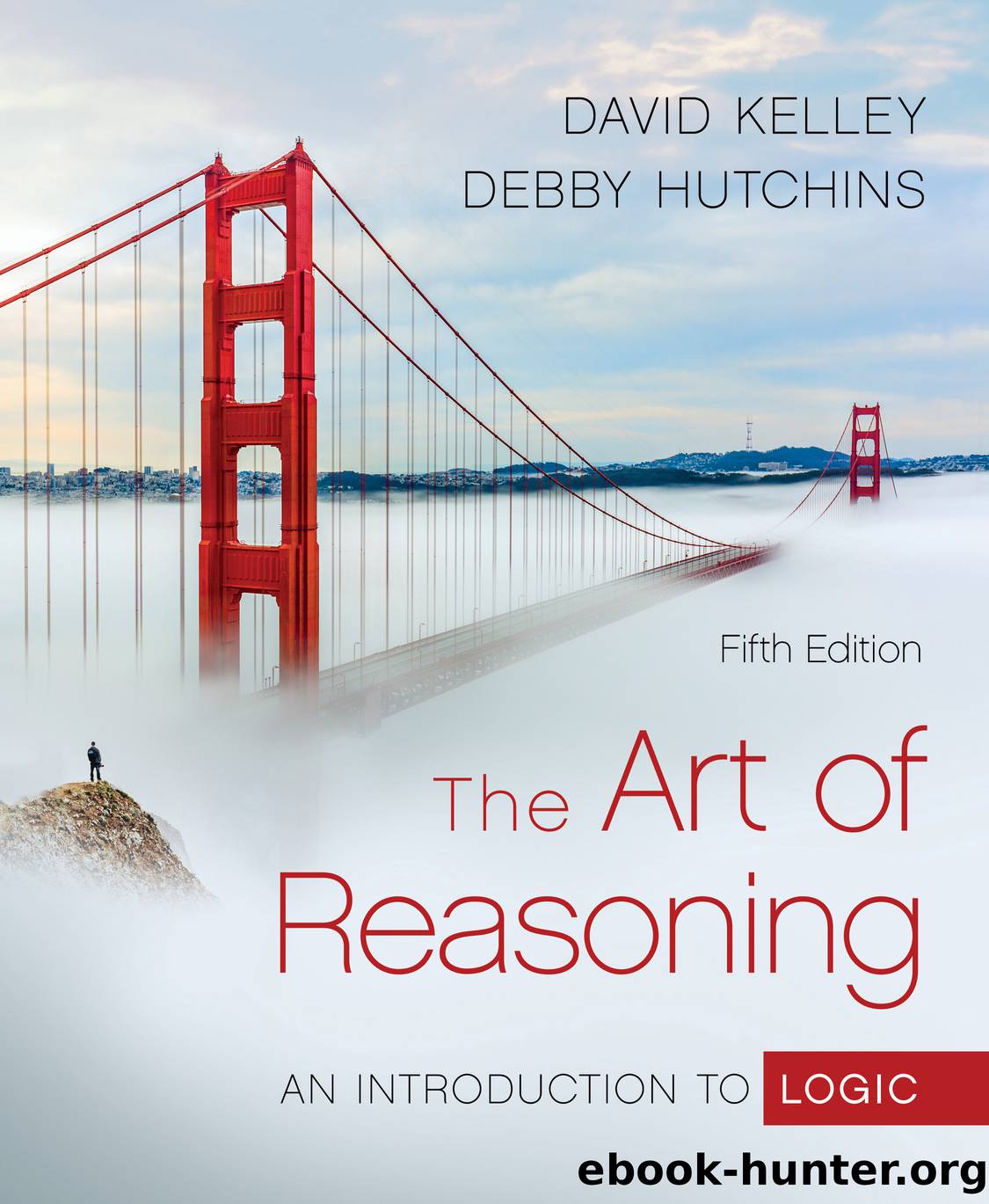Art of Reasoning : An Introduction to Logic (9780393421774) by Kelley David; Hutchins Debby

Author:Kelley, David; Hutchins, Debby
Language: eng
Format: epub
Publisher: W W Norton College
We can adapt this procedure to test for the validity of an argument. Letâs work with the argument about Shakespeare:
~W â D
~D
* * *
W
If we were creating a truth table for the first premise alone, it would look like this:
~ W â D
F T T T
F T T F
T F T T
T F F F
To create a truth table for the argument, we create additional columns to represent the second premise and the conclusion, with a forward slash before the conclusion in order to separate it from the premises:
Premise 1 Premise 2 / Conclusion
~ W â D ~ D / W
T T T
T F F
F T T
F F F
As with truth tables for individual statements, each atomic component that appears more than once must have the same truth value on each row. So in the columns under premise 2 and the conclusion, the atomic statements D and W must have the same truth values on each row that each has in premise 1.
We now compute the truth values of each premise and of the conclusion, putting the result under the main connective for each statement. The procedure is exactly the same as with truth tables for single statements, except that now we have three different statements, whose truth values are represented in the three shaded columns.
Premise 1 Premise 2 / Conclusion
~ W â D ~ D / W
F T T T F T T
F T T F T F T
T F T T F T F
T F F F T F F
The test for validity is whether the conclusion can be false while the premises are both true. So the first step is to look at the column under the conclusion and flag the rows on which it is falseârows 3 and 4:
Premise 1 Premise 2 / Conclusion
~ W â D ~ D / W
F T T T F T T
F T T F T F T
T F T T F T F
T F F F T F F
Now we check the premises on those rows in order to see whether they are both true.
Premise 1 Premise 2 / Conclusion
~ W â D ~ D / W
F T T T F T T
F T T F T F T
T F T T F T F
T F F F T F F
In row 3, the premise ~D is false, and in line 4 the premise ~W â D is false. Since the truth table shows us every combination of possible truth values, we have just established that thereâs no way this argument could have true premises and a false conclusion, which is the standard for validity. So this argument is valid.
When we use truth tables to determine whether an argument is valid or invalid, we are concerned only with the truth values of the premises and conclusion as whole statementsâthe truth values in the shaded columns. For compound statements such as premises 1 or 2 in the previous argument, we disregard the truth values of their components and take account only of the columns under their main connectives.
Download
This site does not store any files on its server. We only index and link to content provided by other sites. Please contact the content providers to delete copyright contents if any and email us, we'll remove relevant links or contents immediately.
The European Opportunity by Felipe Fernández-Armesto(562)
The European History Highway: A Guide to Internet Resources by Dennis A. Trinkle Scott A. Merriman(514)
The Seven Wonders of the Ancient World by Michael Denis Higgins(505)
European Security in a Global Context by Thierry Tardy(494)
European Security without the Soviet Union by Stuart Croft Phil Williams(489)
The Routledge companion to Christian ethics by D. Stephen Long Rebekah L. Miles(485)
Morgan Kaufmann Digital Watermarking and Steganography by Ingemar Cox Matthew Miller Jeffrey Bloom Jessica Fridrich Ton(469)
Hyperculture by Byung-Chul Han(457)
Get Real with Storytime by Julie Dietzel-Glair & Marianne Crandall Follis(423)
Hudud Al-'Alam 'The Regions of the World' - a Persian Geography 372 A.H. (982 AD) by V. V. Minorsky & C. E. Bosworth(421)
Gorbachev And His Generals by William C. Green(410)
Tibetan Studies in Comparative Perspective by Chih-yu Shih Yu-Wen Chen(406)
Governance, Growth and Global Leadership by Espen Moe(402)
CliffsNotes on Fitzgerald's The Great Gatsby by Kate Maurer(382)
How Languages Are Learned 5th Edition by Patsy M Lightbown;Nina Spada; & Nina Spada(378)
The Oxford History of the World by Fernández-Armesto Felipe;(374)
The Egyptian Economy, 1952-2000 by Khalid Ikram(370)
Oral Poetry and Narratives from Central Arabia: The Poetry of Ad-Dindan : A Bedouin Bard in Southern Najd (Studies in Arabic Literature, Vol 17) (English and Arabic Edition) by P. M. Kupershoek P. Marcel Kurpershoek(357)
The Oxford Handbook of the Incas by Sonia Alconini(351)
